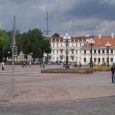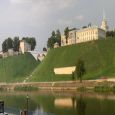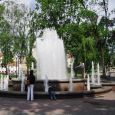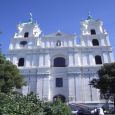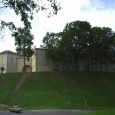Grodno
Advertisement
By Train
The train station at Grodno is where the change of car trucks (wheels and axles) takes place to accommodate different track guages on east and west routes is a place of almost terrifying size, disorder and noise.Carriges is uncoupled from the others and, in turn, is lifted about ten feet as the trucks are changed.This is done without notice and while the operation takes place one has a good view of the acres of rusted, obsolete and unused equipment that litters the area. Domestic trains from Minsk are daily, departing 4:22PM taking five hours, wuth several night trains. There are several international trains from Russia, the one from Moscow is daily and for a 16 h journey. From Saint Petersburg there is up to three departures a week taking 22 h. During summer additional routes are added, Odessa (39 h) via Kiev, Simferopol (37.5 h) and Sochi (62 h). From Poland, you have to travel to the small town of Kuznica just across the border, to get there change trains in Bialystok. A ticket is about 10,000 rubles.Note that cigarette smuggling is very common, and many people will be doing it.
By Bus
There are a lot of buses from Minsk (costs around 45,000 rubles for the express route, which takes 4 h) from Vostochnyj Station or from Druzhnaya Station (behind the main train station), few from Brest (the same price), few from Vilnius, one bus from Warsaw (departure around 10-11 a.m. from Warszawa-Stadion station; a few buses from Moscow.
By Car
Roads are pretty good, you can easily get here from Minsk, Brest, Vilnius (Lithuania), Bialystok, Warsaw (Poland).Be aware of borders, and possible waiting in line (especially on the Polish boarder Kuznica-Bruzgi or, with usually smaller lines, Berestavitsa).
Old Hrodna Castle
Originated in the 11th century as the seat of a dynasty of Black Ruthenian rulers, descended from a younger son of Yaroslav the Wise of Kiev.The 13th-century keep of the castle belonged to a type of Belarusian defensive tower represented by the Tower of Kamyanyets. Vytautas the Great added five Brick Gothic towers in 1391-98, transforming the castle into one of his main residences. Casimir IV Jagiellon also favoured Hrodna over Lithuania's official capital. It was there that the Polish Crown was offered to him, and it was there that he died in 1495.The castle's revival was owing to Krzysztof Zygmunt Pac who raised sufficient funds to finance the refurbishing of the royal residence. The restored castle was selected by King Michael of Poland as the location for every third Sejm of the Polish-Lithuanian Commonwealth. The castle suffered extensive damage during the Great Northern War, forcing the royal court to move into the New Hrodna Castle.After the partitions of Poland the castle was given over to the Russian army and housed a barracks. The authorities of interwar Poland restored the chamber of the ambassadors and the Sejm Hall. At present the castle is classed as a museum.
Batory Square
Is the historical name (during the Polish period in 1921 - 1939) of Soviet (Savyetskaya) Square - the central square for the city of Hrodna in Belarus.It was named after Stephen Báthory, King of Poland who had a residence here in the 16th century.
Great Synagogue of Hrodna
located in Hrodna, Belarus, dates from the 16th century and is a 2007 pretender to UNESCO World Heritage Site.The Great Synagogue of Hrodna was built from 1576 to 1580 by Santi Gucci, who designed a Wooden synagogue at Rabbi Mordechai Yaffe's invitation. In 1887, the Hrodna Jews owned 88% of the commercial enterprises, 76% of the factories and workshops, and over 65% of the real estate in the city. Their property was estimated at 842,000 roubles at a time when the total sum of the city's properties was 1,202,000 roubles. In 1898, one of the first savings and loan cooperatives in Russia was founded in Grodno.
New Hrodna Castle
Is the royal palace of Augustus III of Poland and Stanisław August Poniatowski where the famous Grodno Sejm took place in 1793.The royal residence was built on the high bank of the Neman River at a little distance from the Old Hrodna Castle which had suffered great dilapidation in the aftermath of the Swedish occupation in the early 18th century. The two castles are joined by a 300-year-old arch bridge.Used as a hospital and barracks throughout most of the 19th century, the palace was renovated by the Polish administration in the interwar period. Scarcely anything is left of the original fabric of the castle, whose refined Rococo detailing vanished during the World War II. There followed a hasty and rather superficial refurbishing of the palace by the Soviets with a view to making it the headquarters of a local obkom.A plaque on the wall of the palace commemorates the council of war held in the royal residence by Tadeusz Kościuszko on 30 October 1794.
The Jesuit Cathedral
It is the only surviving monument of ancient Black Ruthenian architecture, distinguished from other Orthodox churches by prolific use of polychrome faceted stones of blue, green or red tint which could be arranged to form crosses or other figures on the wall.The church is a cross-domed building supported by six circular pillars.The outside is articulated with projecting pilasters, which have rounded corners, as does the building itself.The ante-nave contains the choir loft, accessed by a narrow gradatory in the western wall.Two other stairs were discovered in the walls of the side apses; their purpose is not clear.The floor is lined with ceramic tiles forming decorative patterns.The interior was lined with innumerable built-in jugs, which usually serve in Eastern Orthodox churches as resonators but in this case were scored to produce decorative effects.For this reason, the central nave has never been painted.
August - October
February - April


